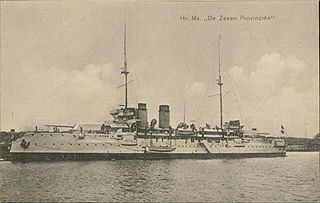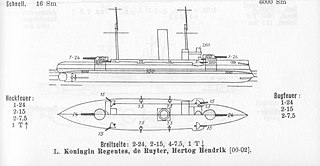 W
WHNLMS De Ruyter was a Koningin Regentes-class coastal defence ship (pantserschip) of the Royal Netherlands Navy. The ship was built by the Maatschappij voor Scheeps- en Werktuigbouw Fijenoord in Rotterdam just after the turn of the 20th century. The ship participated in two colonial expeditions in the Dutch East Indies. She made several journeys to show the flag and was finally decommissioned in 1923.
 W
WHNLMS De Zeven Provinciën was a Royal Netherlands Navy coastal defence ship in service from 1910 until 1942. It was a small cruiser-sized warship that sacrificed speed and range for armor and armament. She was armed with two 283 mm, four 150 mm, ten 75 mm, four 37 mm guns, in addition to a few 75 mm mortars. She was 101.5 metres (333 ft) long, had a beam of 17.1 metres (56 ft) and a draft of 6.15 metres (20.2 ft), and displaced 6,530 tons. She had a crew of 448 and was able to reach 16 knots.
 W
WHNLMS Evertsen was a Evertsen-class coastal defence ship of the Royal Netherlands Navy.
 W
WThe Evertsen class or Kortenaer class was a class of coastal defense ships of the Royal Netherlands Navy. The class comprised Evertsen, Piet Hein and Kortenaer.
 W
WHNLMS Hertog Hendrik was a Koningin Regentes-class coastal defence ship (pantserschip) of the Royal Netherlands Navy. The ship was built at the Rijkswerf in Amsterdam at the start of the twentieth century. She was the first ship in the Dutch navy to be equipped with wireless communication. The ship took part in two expeditions to South Celebes and during the Spanish Civil War she performed convoy duties. During World War II she was captured by the invading German forces and converted into an anti-aircraft battery. After the war the ship was recovered and given back to the Netherlands, to be converted into an accommodation ship.
 W
WHNLMS Jacob van Heemskerck was a unique coastal defence ship of the Royal Netherlands Navy built by the Rijkswerf in Amsterdam. She was among the ships send to patrol the Venezuelan coast during the second Castro crisis. After her active career she was rebuilt into a stationary battery ship and recommissioned. During World War II she was captured by the invading German forces and converted in an anti-aircraft battery. After the war the ship was recovered and given back to the Netherlands, to be converted to an accommodation ship.
 W
WHNLMS Koningin Regentes was a Koningin Regentes-class coastal defence ship (pantserschip) of the Royal Netherlands Navy. The ship was built at the Rijkswerf in Amsterdam at the start of the twentieth century. After the eruption of the Mount Pelée volcano on the French island of Martinique the ship provided assistance to the casualties, and then later participated in an expedition to the island of Bali in 1906. She made several journeys to show the Dutch flag and was finally decommissioned in 1920.
 W
WThe Koningin Regentes class was a class of coastal defence ships of the Royal Netherlands Navy. The class comprised Koningin Regentes, De Ruyter and Hertog Hendrik.
 W
WHNLMS Kortenaer was a Evertsen-class coastal defence ship of the Royal Netherlands Navy.
 W
WHNLMS Marten Harpertszoon Tromp was a unique coastal defence ship of the Royal Netherlands Navy built by the Rijkswerf in Amsterdam.
 W
WHNLMS Piet Hein was a Evertsen-class coastal defence ship of the Royal Netherlands Navy.
 W
WHNLMS De Zeven Provinciën was a Royal Netherlands Navy coastal defence ship in service from 1910 until 1942. It was a small cruiser-sized warship that sacrificed speed and range for armor and armament. She was armed with two 283 mm, four 150 mm, ten 75 mm, four 37 mm guns, in addition to a few 75 mm mortars. She was 101.5 metres (333 ft) long, had a beam of 17.1 metres (56 ft) and a draft of 6.15 metres (20.2 ft), and displaced 6,530 tons. She had a crew of 448 and was able to reach 16 knots.